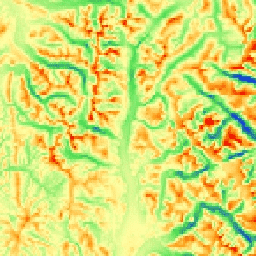
- Доступность набора данных
- 2006-01-24T00:00:00Z–2011-05-13T00:00:00Z
- Поставщик наборов данных
- Партнеры по науке сохранения природы
- Теги
Описание
Индекс mTPI позволяет различать горные и долинные формы. Он рассчитывается на основе данных о высоте каждой точки за вычетом средней высоты в пределах района. Индекс mTPI использует скользящие окна радиусом (км): 115,8, 89,9, 35,5, 13,1, 5,6, 2,8 и 1,2. Он основан на 30-метровой цифровой модели рельефа SRTM (доступной в EE как USGS/SRTMGL1_003).
Наборы данных по экологически релевантной геоморфологии (ERGo), формам рельефа и физиографии, разработанные Conservation Science Partners (CSP), содержат подробные многомасштабные данные о формах рельефа и физиографических (т.н. «фасетных» характеристиках рельефа). Несмотря на множество потенциальных применений этих данных, изначальной целью их создания была разработка экологически релевантной классификации и карты форм рельефа и физиографических классов, подходящих для планирования адаптации к изменению климата. В связи с высокой неопределенностью, связанной с будущими климатическими условиями, и еще большей неопределенностью, связанной с экологическими реакциями, предоставление информации о том, что вряд ли изменится, дает руководителям надежную основу для разработки надежных планов адаптации к изменению климата. Количественная оценка этих характеристик ландшафта чувствительна к разрешению, поэтому мы предоставляем максимально возможное разрешение с учетом масштаба и характеристик данного индекса.
Группы
Размер пикселя
270 метров
Группы
| Имя | Единицы | Мин. | Макс | Размер пикселя | Описание |
|---|---|---|---|---|---|
elevation | м | -8129* | 7905* | метров | mTPI, полученный с помощью SRTM, варьируется от отрицательных (долины) до положительных (гребни) значений |
Условия эксплуатации
Условия эксплуатации
Цитаты
Теобальд, Д.М., Харрисон-Атлас, Д., Монахан, У.Б., и Альбано, К.М. (2015). Экологически значимые карты рельефа и физико-географического разнообразия для планирования адаптации к изменению климата. PloS one, 10(12), e0143619
Исследуйте с Earth Engine
Редактор кода (JavaScript)
var dataset = ee.Image('CSP/ERGo/1_0/Global/SRTM_mTPI'); var srtmMtpi = dataset.select('elevation'); var srtmMtpiVis = { min: -200.0, max: 200.0, palette: ['0b1eff', '4be450', 'fffca4', 'ffa011', 'ff0000'], }; Map.setCenter(-105.8636, 40.3439, 11); Map.addLayer(srtmMtpi, srtmMtpiVis, 'SRTM mTPI');
